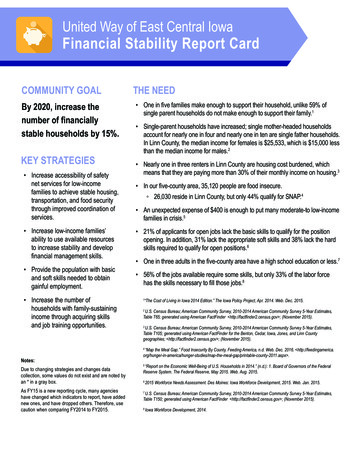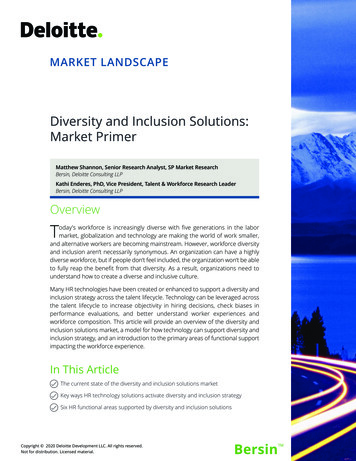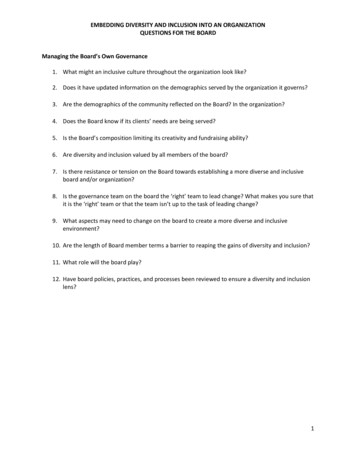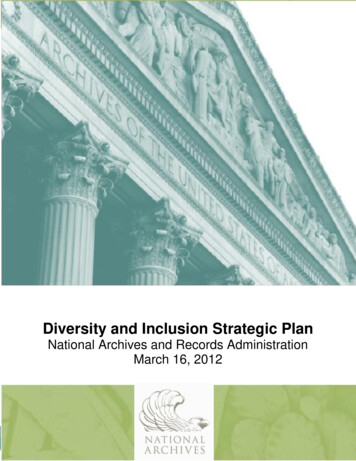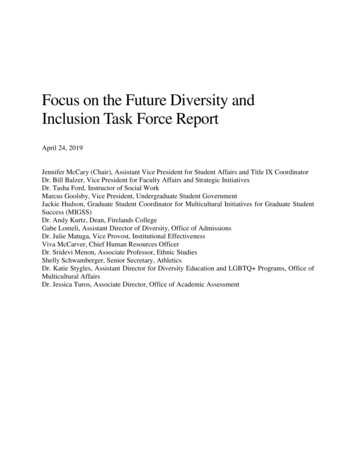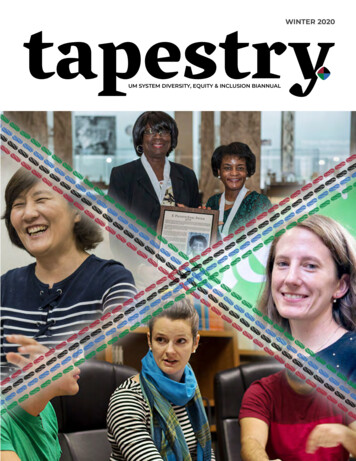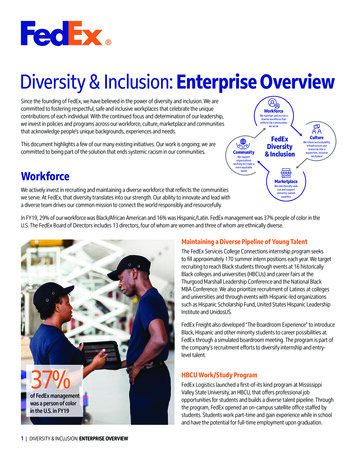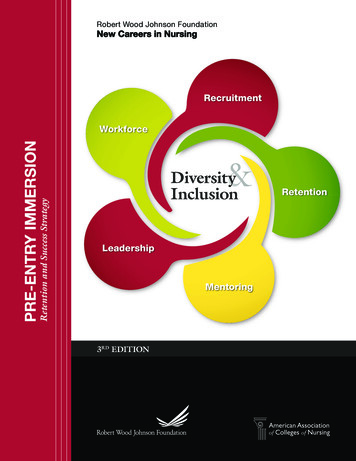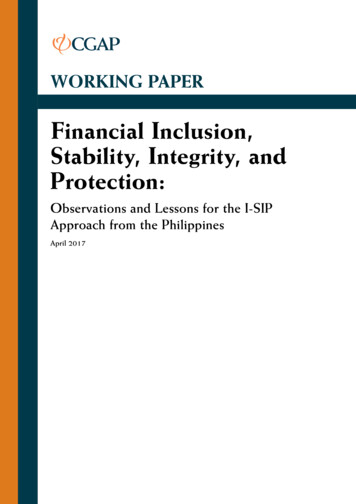
Transcription
WORKING PAPERFinancial Inclusion,Stability, Integrity, andProtection:Observations and Lessons for the I-SIPApproach from the PhilippinesApril 2017
TABLE OF CONTENTSCURRENCY AND EQUIVALENT UNITS. IVABBREVIATIONS. IVACKNOWLEDGMENTS. VII1.INTRODUCTION: THE I-SIP APPROACH. 11.1 Background. 11.2 Research approach. 21.3 I-SIP research exercise in the Philippines. 42.1.4 This report. 5STATE OF FINANCIAL INCLUSION IN THE PHILIPPINES. 62.1 The Philippines’ commitment to financial inclusion. 62.2 Key access and usage data. 73.2.3 Definition and measurement of financialinclusion in the Philippines.10ANALYSIS OF POLICY INTERVENTIONS. 113.1 Mandated agricultural credit.113.2 National Strategy for Microfinance.203.3 Electronic money guidelines.293.4 Regulations for microbanking offices.373.5 Draft regulations for pawnshops.444.3.6 Summary of linkages in policy interventions.52OBSERVATIONS ON THE PHILIPPINES I-SIP AND NEXT STEPS. 544.1. Observations vis-à-vis the I-SIP Propositions.544.2. Next steps.60ANNEX 1. INTERVIEWS. 61ANNEX 2. FINANCIAL SERVICES ACCESS POINTSIN THE PHILIPPINES. 65REFERENCES. 68III
Financial Inclusion, Stability, Integrity, and Protection: Observations and Lessons for the I-SIP Approach from the PhilippinesCURRENCY AND EQUIVALENT UNITS(As of February 29, 2016)Currency Unit 5 Philippine peso (PhP)US 1 5 PhP 47.56ABBREVIATIONS4PsPantawid Pamilyang Pilipino ProgramAMLAnti-Money launderingASEANAssociation of Southeast Asian NationsAGFPAMLCSAgricultural Guarantee Fund PoolAnti-Money Laundering Council SecretariatATMAutomated Teller MachineBFABankable Frontier AssociatesBAPBankers Association of the PhilippinesBSPBangko Sentral ng PilipinasCAMELS apital adequacy, Asset quality, Management, Earnings, Liquidity,CSensitivity to market risksCALGCDACEOCentral Applications and Licensing GroupCooperative Development AuthorityChief Executive OfficerCEBGCard and e-Banking GroupCGAPConsultative Group to Assist the PoorDFIDUnited Kingdom Department for International DevelopmentCFTCPIPDOFDSWDDTIEMIFATFCombating the Financing of TerrorismCredit Policy Improvement ProgramDepartment of FinanceDepartment of Social Welfare and DevelopmentDepartment of Trade and IndustryElectronic money issuerFinancial Action Task ForceIV
Financial Inclusion, Stability, Integrity, and Protection: Observations and Lessons for the I-SIP Approach from the PhilippinesFCPDFinancial Consumer Protection DepartmentG2PGovernment to PersonGSMAGSM AssociationICInsurance CommissionI-SIPInclusion, Stability, Integrity, ProtectionGPFIGXIIMFKYCGlobal Partnership for Financial InclusionG-Xchange, Inc.International Monetary FundKnow Your CustomerLBPLand Bank of the PhilippinesMBOMicrobanking OfficeMFIMicrofinance InstitutionLCDPMCPILoan Collection and Disbursement PointMicrofinance Council of the Philippines, Inc.MiDASMicrofinance Data Sharing SystemMSMEMicro, Small, and Medium-Sized EnterprisesMORNBFIManual of Regulations for Non-bank Financial InstitutionsNBFINonbank Financial InstitutionNGONongovernmental OrganizationNCCTNPLNSSLANon-Cooperative Countries and TerritoriesNonperforming LoansNonstock Savings and Loan AssociationNTCNational Telecommunications CommissionPCFCPeople’s Credit and Finance CorporationOBOOther Banking OfficePCICPhilippine Crop Insurance CorporationPDRPeople’s Democratic RepublicPDICPESOPhilippine Deposit Insurance CorporationPortfolio quality, Efficiency, Sustainability, OutreachV
Financial Inclusion, Stability, Integrity, and Protection: Observations and Lessons for the I-SIP Approach from the PhilippinesRARepublic ActROAReturn on AssetsSECSecurities and Exchange CommissionROESIMSMSReturn on EquitySubscriber Identification ModuleShort Message ServiceSSBStandard-Setting BodyTSSTechnical Support ServicesTILAUNUSAIDTruth in Lending ActUnited NationsUnited States Agency for International DevelopmentVI
Financial Inclusion, Stability, Integrity, and Protection: Observations and Lessons for the I-SIP Approach from the PhilippinesACKNOWLEDGMENTSThis study was conducted at the request of Bangko Sentral ng Pilipinas (BSP), thecentral bank of the Philippines. The objective of the study was to analyze how thelinkages among financial inclusion, stability, integrity, and consumer protection havebeen managed in the case of four existing policies (mandated agricultural credit,National Strategy for Microfinance, electronic money guidelines, and regulationsfor microbanking offices) and one policy to be implemented (draft regulations forpawnshops). The study includes the results of a visit from a Consultative Group toAssist the Poor (CGAP) team to the Philippines 11–20 August 2015 and a follow-upanalysis covering developments through February 2016.This study was conducted by a joint research team from CGAP and BSP. The teamwas led by Olga Tomilova and included Eric Duflos, Juan Carlos Izaguirre, and MyraValenzuela (all CGAP), and Pia Roman Tayag, Rochelle Tomas, Mary Ann Cuevas,and Mynard Mojica (all BSP). Overall guidance was provided by Timothy Lyman,Katharine Lauer, Stefan Staschen (all CGAP), and Nestor Espenilla (BSP).The team wishes to express its gratitude to BSP for its strong support and assistanceduring this visit, and to the wide range of stakeholders from government, private,and nonprofit sectors who contributed to the study through interviews. A completelist of persons interviewed is presented in Annex 1.No endorsement of this report was sought from any party, nor should any be inferredfrom participation in the consultative process by which it was developed.VII
Financial Inclusion, Stability, Integrity, and Protection: Observations and Lessons for the I-SIP Approach from the Philippines1. INTRODUCTION: THE I-SIP APPROACHare linked and how policy makers can optimize the linkages to minimize tradeoffsand other negative outcomes and to maximize synergies. This work stream buildsthe evidence base to implement a callby the G20 Finance Ministers and Central Bank Governors in their November2012 communiqué for SSBs to provideguidance and engage with the G20 Global Partnership for Financial Inclusion(GPFI) to study the I-SIP linkages.21.1 BackgroundFinancial-sector policy makers and international standard-setting bodies (SSBs)have traditionally sought to create theconditions for financial stability. Overthe past two decades increasingly moreattention has been paid to financial integrity (i.e., preventing financial crimesthrough, for example, anti- money laundering [AML] and combating the financing of terrorism [CFT] programs) andfinancial consumer protection, particularly in the wake of the 2008–2009 global financial crisis. Financial inclusion—amore recent addition to the list of corepolicy objectives for financial-sectorregulation and supervision—has received increasing global recognition bythe United Nations, G20 Leaders andFinance Ministers/Central Bank Governors, SSBs, and other global bodies.Moreover, financial inclusion has foundits way into country-level policy making.Relevant policy-making bodies in morethan 50 countries around the world havecommitted to measurable targets for improving financial inclusion domesticallyunder the Maya Declaration, the Alliancefor Financial Inclusion’s initiative to encourage national commitments to financial inclusion.1The original concept for the study wasdeveloped by Martin Alsop (UnitedKingdom Department for InternationalDevelopment [DFID]), Timothy Lyman(CGAP), and David Porteous (Bankable Frontier Associates [BFA]). DFID,in its capacity as Co-Chair of the GPFISubgroup focused on engagement withthe SSBs, funded CGAP (a GPFI Implementing Partner) to conduct an initialresearch exercise in South Africa to inform the work of the Subgroup. In 2012,CGAP carried out a pilot research exercise in South Africa to begin developinga framework to study I-SIP linkages inthe context of country-level policy making, to gain deeper understanding onwhether and how the I-SIP objectivescan be mutually reinforcing, and ultimately to confirm that increased financial inclusion can result in a positive (orat least no negative) effect on the otherthree objectives. CGAP also sought todevelop a methodology to help policymakers optimize the linkages in practice. As a result of this work, CGAP formulated the I-SIP Approach to designingor adjusting financial-sector policiesthat involves identifying, managing, andoptimizing the linkages among the I-SIPIn collaboration with many such actors, in2011 CGAP embarked on a work streamaimed at understanding how policy making changes when financial inclusion isadded as a core objective—and morespecifically how the four policy objectives (I for financial inclusion, S for financial stability, I for financial integrity, and Pfor financial consumer protection [I-SIP])1 The Alliance for Financial Inclusion is an international network of policy makers and regulators committed to promotingfinancial inclusion. See http://www.afi-global.org/maya-declaration.2 GPFI was created in 2010 as an inclusive platform for all G20 countries, interested non-G20 countries, and relevant stakeholders to carry forward work on financial inclusion, including implementation of the G20 Financial Inclusion Action Plan(http://www.gpfi.org/about-gpfi). The terms of reference and work plan of the GPFI Subgroup on Regulation and SSBs provide further details on GPFI’s work with SSBs ard-setting-bodies).1
Financial Inclusion, Stability, Integrity, and Protection: Observations and Lessons for the I-SIP Approach from the Philippinesobjectives triggered by a given policyintervention. To guide policy makers onhow to implement the I-SIP Approachmore effectively, CGAP proposed a setof I-SIP Propositions (Box 1).3 To advance the understanding of the linkagesamong the I-SIP objectives and to refinethe I-SIP Approach, similar researchexercises were undertaken in Pakistan(2013) and in Russia (2013–2014).1.2 Research Approach4A growing body of research including thefour I-SIP research exercises conductedby CGAP suggests that whether broad-BOX 1. The I-SIP Approach and PropositionsI-SIP Approach. To optimize policy outcomes, policy makers should seek to identifyand analyze the linkages among financial inclusion, stability, integrity, and protection(the I-SIP objectives) triggered by a given policy intervention (ideally, ex ante). Policymakers should manage these linkages over time proportionately to their observedeffect (in the case of ex-post analysis) or expected impact (in the case of ex-anteanalysis). This process should be integrated in and systematically followed duringregular policy-making processes, based on the following six I-SIP Propositions:1. C lear definitions. Clear definitions for each of the I-SIP objectives at the national level and at the level of specific policy interventions are needed to guidepolicy makers in policy design. The definitions at the policy intervention levelshould be detailed enough to allow for measuring the effects of the interventionwith regard to I-SIP objectives.2. Structured approach. A structured approach to identifying material linkagesamong I-SIP objectives that may arise in the implementation of a specific policyintervention helps to manage and optimize linkages, thereby avoiding false or unnecessary tradeoffs between objectives and maximizing synergies among them.3. C ollaboration. Inter- and intra-agency collaboration is critical to design, monitor, and adapt policy interventions to optimize the linkages among I-SIP objectives, as well as linkages with national objectives beyond the I-SIP objectives.4. R egular data. Regularly collected and analyzed data based on indicators andtargets specific to a given policy intervention enable the monitoring of its effects on the I-SIP objectives and the management of linkages over time.5. C onsultation with providers.a Periodic structured consultation with providersin proportion to the scale of the proposed policy changes helps to identify andmanage linkages as the market develops.6. Policy adaptation. Optimization of I-SIP linkages requires a commitment by policy makers to manage the I-SIP linkages by adapting policy and regulation asnecessary in light of the data and other evidence collected and effects observed.a. One form of such consultation is a so-called regulatory sandbox—a regulatory approach that allows for testinginnovations in a controlled environment and can help supervisors understand innovations and foster responsible innovation in the market.3 CGAP (2012) referred to the seven I-SIP propositions as “guidance statements”; these were later replaced with six “propositions.”4 For more detailed information, see Staschen (2014b) and Staschen (2014a).2
Financial Inclusion, Stability, Integrity, and Protection: Observations and Lessons for the I-SIP Approach from the Philippinesbased access to and use of formal financial services promotes financial stability depends on how that access and useis managed within the regulatory andsupervisory framework, especially interms of financial integrity and consumer protection. These four factors: financial inclusion, stability, integrity, andconsumer protection are inter-relatedand, under the right conditions, positively related. Yet, in many cases, failingson one dimension have been found tolead to problems on others.5the I-SIP objectives. Linkages among theI-SIP objectives were analyzed in pairsfor each of the selected policy interventions, focusing on the linkages betweenfinancial inclusion and each of the otherthree objectives.6 For each pair of linkages, there were nine possible outcomes asshown in Figure 1.The I-SIP research exercises conductedso far have shown that both synergies andtrade-offs among the I-SIP objectives arepossible, highlighting both the challengeand the goal for policy makers to createpolicies that lead to outcomes falling inthe green zones and avoiding the grayand red zones (or at least minimizing thetradeoffs and other negative outcomes).The I-SIP Approach and the I-SIP Propositions are intended to help achieve thisgoal.7 Box 1 presents the definition of theI-SIP Approach, which incorporates theevolving thinking and insights from allfour I-SIP research exercises.The I-SIP research study involved selecting policy interventions (cases) foranalysis, collecting information abouteach of the selected cases through theanalysis of available data, reviewing relevant secondary sources, interviewingrelevant stakeholders, and synthesizing learnings from the cases, with anemphasis on identifying the observedeffects of each of the cases on each ofFIGURE 1. Possible pair-wise linkage zones: Financial inclusion and stabilityPositiveNegativeNonePositiveStability enhancing, inclusion reducingStability without effect on inclusionSynergyIneffective policyInclusion withouteffect on stabilityNoneNegativeImpact on Financial StabilityImpact on financial inclusionInclusion enhancing, stability reducingLose-lose5 See Cull, Demirgüç-Kunt, and Lyman (2012) and Sahay et al. (2015).6 In contrast to a regulatory impact assessment focused on measuring impact, the I-SIP research attempts to explain theprocess of managing linkages and understanding how this can elucidate the observed effects.7 The I-SIP Propositions were designed in the context of the I-SIP research. However, they function more broadly as essentialcomponents of effective policy making, including for objectives other than I-SIP (i.e., employment generation, competition,poverty alleviation, inequality reduction, and faster economic growth).3
Financial Inclusion, Stability, Integrity, and Protection: Observations and Lessons for the I-SIP Approach from the Philippines1.3 I-SIP Research Exercise in thePhilippinesor regulation, either adopted (ex-post)or under development (ex-ante)—thatwas analyzed to elucidate I-SIP linkages and to generate lessons learned onhow policy makers can perform their responsibilities in a structured way whilekeeping in mind the linkages. The casesanalyzed are presented chronologically:The Philippines is the fourth countryin which an I-SIP research exercise hasbeen conducted. The field interviews forthis exercise were conducted in August2015.8 They followed a series of discussions between CGAP and BSP regardingexperiences balancing I-SIP linkages inrelevant Philippine policy making. ThePhilippines was chosen for the researchbecause of its public commitment to financial inclusion and numerous policyinterventions in support of this objective. Specific goals for the Philippines I-SIPincluded the following: Contribute to further refinement ofthe research approach and conceptual deepening of understandingI-SIP linkages based on observedeffects of select Philippine policy interventions. Contribute to further refinement ofthe I-SIP Approach overall and specific I-SIP Propositions (see Box 1)based on the Philippine experience. Raise awareness of I-SIP linkagesamong relevant Philippine regulators, supervisors, and policy makers,positioning them to better optimizethe four policy objectives in theirwork.Presidential Decree 717 on mandated agricultural credit (1975, asamended by Republic Act No. 10000or the Agri-Agra Reform Credit Act of2009).The National Strategy for Microfinance (1997) and related laws andregulations.BSP Circular 649: Guidelines governing the issuance of electronic money and the operations of electronicmoney issuers in the Philippines(2009).BSP Circular 694 allowing the establishment of microbanking offices(2010).BSP draft regulations on pawnshops(2015, ex-ante policy case).The cases were selected based on thefollowing criteria: (i) demonstration of alinkage is expected, i.e., an interventionwith an expected positive effect on one ofthe I-SIP objectives could also be expected to have an observable effect (positiveor negative) on one or more of the otherI-SIP objectives; (ii) availability of relevantdata and qualitative evidence to supportthe analysis; (iii) for the ex-post cases, passage of sufficient time from the intervention to consider observable effects; (iv) forthe ex-ante case, potential for the analysisto be useful in an on-going policy-makingprocess; and (v) relevance of the case toother countries and potential to contribute to the global learning agenda.Help BSP and other relevant Philippine policy-making bodies toadopt the I-SIP Approach in future policy-making efforts.Develop insights for possible independent application of the I-SIP Approach by interested countries.The I-SIP study in the Philippines focuses on five policy cases. Each caserepresents a policy intervention—a law8 See Annex 1 for a list of interviews.4
Financial Inclusion, Stability, Integrity, and Protection: Observations and Lessons for the I-SIP Approach from the PhilippinesFor each case, the research team systematically sought to understand the following key questions: Did policy makers identify potential linkages between financial inclusion, financial stability, financial integrity, and financial consumerprotection at the time of designingthe intervention?How has the application of theI-SIP Propositions contributed tothe achievement of optimal policyoutcomes?1.4 This ReportThe field research for this report was conducted by a joint team from CGAP and BSPin August 2015 and reflects the developments through February 2016. Section 2of this report presents relevant information on the current state of financial inclusion and financial inclusion initiatives inthe Philippines to put the analysis of thefive policy cases examined in a broad context. Section 3 includes the analysis of thefive policy initiatives through the lens ofthe I-SIP Approach. The report concludeswith observations and lessons learned asa result of the Philippines I-SIP researchthat may be relevant for other countriesas they work on advancing financial inclusion (Section 4).What discussions and actions tookplace (if any) to measure and manage potential tradeoffs or synergiesbetween the I-SIP objectives?What has been the observed effect ofthe intervention on the I-SIP objectives to date using supporting data?From the evidence, to what extentcould the process be characterizedas an attempt to optimize outcomes(i.e., minimize tradeoffs and other negative effects and maximize synergies)?5
Financial Inclusion, Stability, Integrity, and Protection: Observations and Lessons for the I-SIP Approach from the Philippines2. STATE OF FINANCIAL INCLUSION IN THE PHILIPPINESThis section presents a brief history offinancial inclusion interventions andbackground on the state of financial inclusion in the Philippines. This information is presented to put the analysis ofthe five policy cases examined using theI-SIP Approach into a broader context.institutionalizing the principles of theNational Strategy for Microfinance.These efforts resulted in an observedcommercialization and professionalization of the microfinance industry inthe country, represented by banks andmicrofinance institutions (MFIs)10 (seeSection 3.2).2.1 The Philippines’ Commitmentto Financial InclusionIn parallel to the developments of microfinance in the banking and nonbanking(financial cooperatives and MFIs) sectors, the National Credit Council together with the other regulators of financialservices providers—Insurance Commission, BSP, Securities and ExchangeCommission (SEC), and Cooperative Development Authority (CDA)—worked toestablish a robust regulatory environment for microinsurance provision inthe Philippines. A National Strategy andRegulatory Framework for Microinsurance was established in 2010 to pave theway for the increase in microinsurancecoverage in the country.The Philippines has a long history ofattempts to bring unserved and underserved segments of the populationinto the formal financial system. Theseattempts include, among others, government-directed credit programsinitiated in the 1970s that had limited success (see Section 3.1). A turningpoint in this effort was the adoption ofthe National Strategy for Microfinancein 1997, which was spearheaded by theNational Credit Council.9 The NationalStrategy for Microfinance envisionedthe creation of a viable and sustainablemicrofinance market that would helpprovide poor households, including microentrepreneurs, with greater accessto microfinance products and services.Through the National Strategy for Microfinance, the government aimed to rationalize inefficient government creditprograms, accorded the private sector agreater role in microfinance, supportedmarket-based principles, and committed to the creation of a supportive andappropriate policy environment andinstitutional framework for the microfinance market. Several laws and statutes were passed, echoing and furtherIn the past decade, BSP has championedfinancial inclusion efforts in the Philippines. Alongside its traditional role as acentral monetary authority, BSP’s corporate strategy emphasizes its commitment to promoting financial inclusion,financial education, and consumer protection. The BSP initiatives in microfinance, as part of the implementation ofthe National Strategy for Microfinance,11have naturally progressed to an advocacy for financial inclusion, with theultimate objective of providing accessto finance not just to microenterprises,but to every sector currently unserved9 The National Credit Council was established by a Presidential order and included members from selected government ministries and agencies, banking associations, cooperative federations and basic sector organizations. This Council is chairedby the Department of Finance. BSP is a member. For more details see: o-86-s-1993/10 MFIs in the Philippines include banks, cooperatives and microfinance nongovernmental organizations.11 This influenced the inclusion of microfinance-specific provisions in the General Banking Law of 2000, providing an impetusfor BSP to mainstream microfinance as a banking activity.6
Financial Inclusion, Stability, Integrity, and Protection: Observations and Lessons for the I-SIP Approach from the Philippinesor underserved by the formal financialsystem. To coordinate and promote efforts toward the expanded objective offinancial inclusion, BSP transformed itsMicrofinance Unit (established in 2002)into the Inclusive Finance Advocacy Staffin 2007. A Microfinance Committee (alsoestablished in 2002), which providedoversight on the program and activitiesof the Microfinance Unit, was reconstituted in 2012 as the Inclusive FinanceSteering Committee headed by the BSPGovernor. The Committee consists ofBSP top managers and is supported byfour interdepartmental working groupsthat are focused on implementing BSP’sfour financial inclusion agenda components: policy and regulation, financialeducation and consumer protection,data and measurement, and advocacyactivities.The vision of the National Strategy forFinancial Inclusion is to provide effective financial access to a wide range offinancial services to all Filipinos. It defines what, why, and how financial inclusion can be pursued by the publicand private sectors together by settinga framework for systematic collaboration. The National Strategy for FinancialInclusion contains strategic statementsin BSP’s four financial inclusion agenda components. In a way, the NationalStrategy for Financial Inclusion sharesBSP’s approach to financial inclusion,and calibrates it so that other stakeholders can use it to take on activities thatpromote financial inclusion and supportinclusive growth.The National Strategy for Financial Inclusion was officially launched in July2015 in the presence of high-level government officials, Her Majesty QueenMáxima of the Netherlands, the UnitedNations Secretary-General’s Advocatefor Inclusive Finance for Development,and nearly a thousand public- andprivate-sector stakeholders. The launchgenerated increased interest from various stakeholders to participate in theStrategy implementation process.BSP’s commitment to financial inclusionis globally renowned. In 2008, BSP became one of the founding members ofthe Alliance for Financial Inclusion, andin 2011, it signed the Maya Declaration.BSP recognized that financial inclusionis an important element of inclusivegrowth that can be achieved only whenmultiple factors like macroeconomic stability, good governance, infrastructure,innovation, and other socioeconomicfactors are at their optimum levels. In2014, BSP spearheaded efforts to establish the National Strategy for FinancialInclusion. It prepared the initial draftof the National Strategy for FinancialInclusion and convened an interagencybody comprising 13 government agencies that contributed to developing thisstrategy through a highly consultativeprocess.122.2 Key Access and Usage DataThe Philippine financial system has become more inclusive over the years asevidenced by data on financial serviceaccess points and usage of financialservices.13 However, important gapsstill remain, reflecting the challengesof an archipelago country comprising7,107 islands with a population of morethan 100.98 million people.1412 This interagency body has been recently institutionalized as the Financial Inclusion Steering Committee and tasked withoverseeing the implementation of the National Strategy for Financial Inclusion by Executive Order No. 208, 02 June 2016.13 The first World Bank Findex study on use of financial services was conducted in 2011.14 Unless noted otherwise, all data in this section are provided by BSP. The population figure is the official count of the Philippine Statistics Authority (2015).7
Financial Inclusion, Stability, Integrity, and Protection: Observations and Lessons for the I-SIP Approach from the PhilippinesAccess The number of bank branches from2014 to 2015 increased by 3.8 percent from 10,315 to 10,710, andthe number of automated teller machines (ATMs) grew by 10.3 percentfrom 15,692 to 17,314 over the sameperiod. According to InternationalMonetary Fund (IMF) statistics, in2014 there were 8
under the Maya Declaration, the Alliance for Financial Inclusion’s initiative to en-courage national commitments to finan-cial inclusion.1 In collaboration with many such actors, in 2011 CGAP embarked on a work stream aimed at understanding how policy mak-ing changes when
